EU Elections 2024: What Topics Are the European Political Groups Talking About on Social Media?
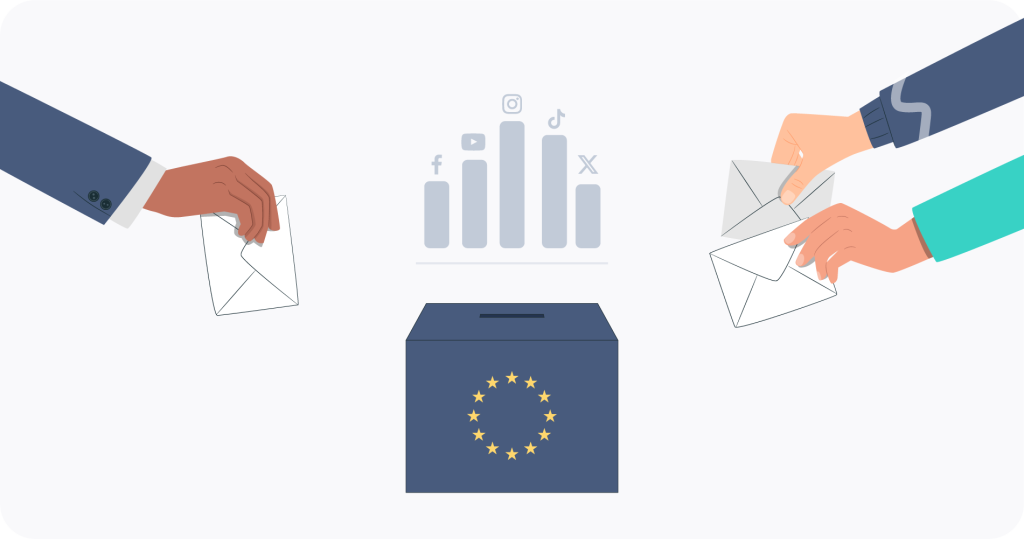
Social networks are an indispensable tool for political campaigns, and the upcoming European election in June 2024 is no exception. But how are the various EU party groups positioning themselves in the digital space? What issues are they pushing on platforms such as Instagram, TikTok, Twitter, or Facebook, and how is the public reacting with this content?
Our comprehensive EU election dashboard [password: 2024] allows you to follow what is happening on the social media accounts of the political groups represented in the European Parliament and their lead candidates on a daily basis. The political groups currently represented in the European Parliament are the European People’s Party (EPP), the Progressive Alliance of Socialists and Democrats (S&D), Renew Europe (Renew), the Greens/European Free Alliance (Greens/EFA), the Left (Left), the European Conservatives and Reformists (ECR) and Identity and Democracy (ID).
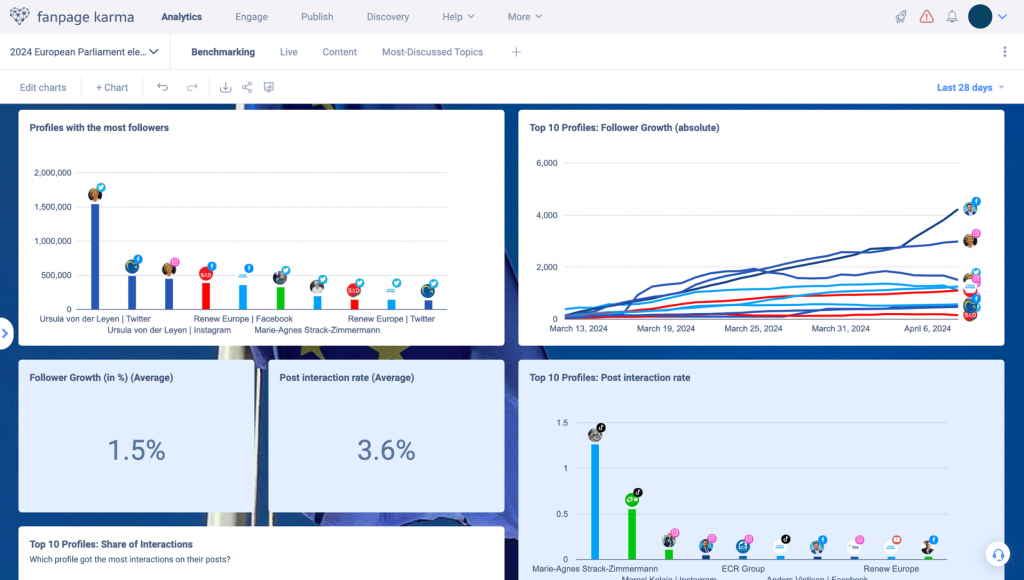
In addition to current follower numbers, follower growth, and engagement rates, the dashboard also shows the best-performing posts on the various platforms in order to paint a differentiated picture of the current European political landscape.
The 2024 European Elections on Social Media
We have prepared the most important facts and figures from our dashboard for you in this article (as of April 4, 2024). You can access the latest data at any time in our dashboard’s benchmarking report.
Top 10: Number of Followers
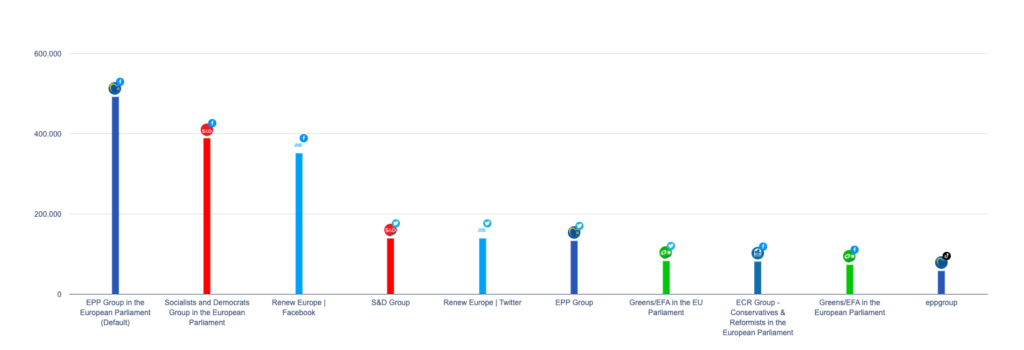
Looking only at the total number of followers, the Facebook accounts of the European People’s Party (EPP), the Progressive Alliance of Socialists and Democrats (S&D), and Renew Europe lead the top 10 with the most fans, followed by the Twitter profiles of S&D, Renew, EPP and the Greens/EFA. Facebook and Twitter therefore theoretically have the greatest potential reach – but in reality, things are not always as they appear. If we list the party groups according to the growth of their profiles and actual interaction, a more differentiated picture emerges.
Top 10: Follower Growth
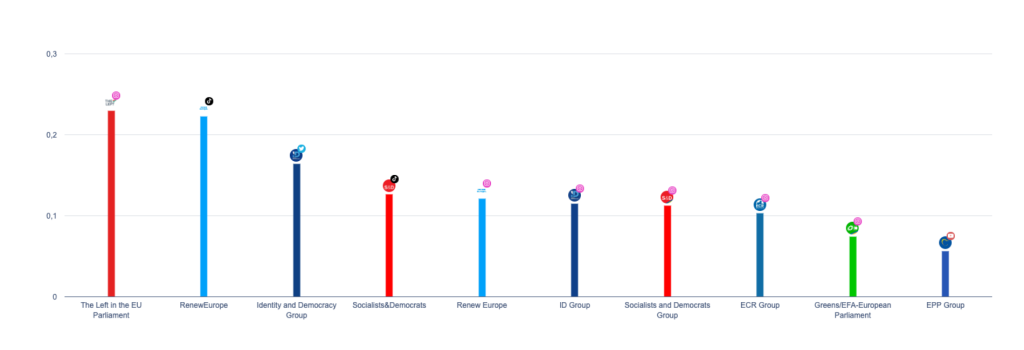
The largest growth in followers is mainly seen on two of the social networks: Instagram and TikTok. Instagram had already gained a lot of relevance for the parties in the last European elections in 2019 and this trend is continuing this year. The rapid growth of TikTok in recent years is also reflected in the rising follower numbers of the party groups.
The top 10 is led by the Left (Instagram, growth of 23%), Renew Europe (TikTok, growth of 22%), ID (Twitter, growth of 16%), S&D (TikTok, growth of 13%), and Renew Europe (Instagram, growth of 12%). All figures relate to the period between January and March 2024.
At first glance, the Identity and Democracy Group in the EU Parliament (ID) may stand out here due to its strong percentage growth on Twitter. However, a comparison of the absolute follower numbers of the party groups on Twitter shows that the right-wing populists are still in last place by a wide margin (e.g. 139k followers of the S&D vs. 4.5k followers of the ID Group; as of April 2024).
However, a large increase in followers does not mean that the followers actually see the posts or even interact with them. We should actually be asking about what channels the parties can activate their voters and generate the most interactions.
Top 10: Interaction Rate
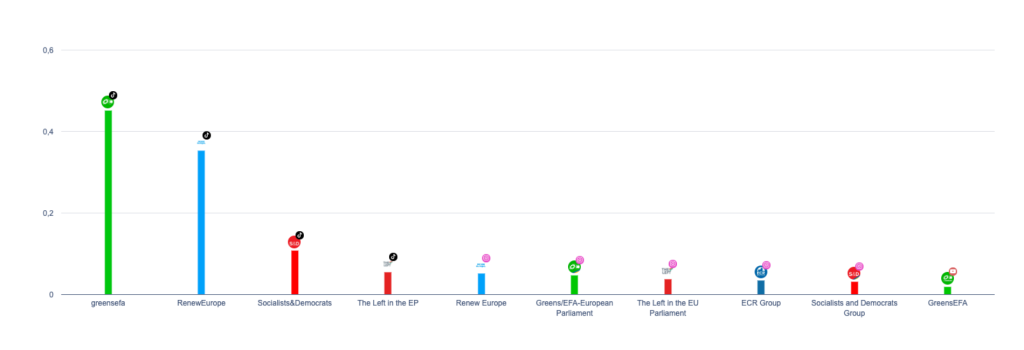
The largest proportion of the respective target group can clearly be persuaded to like, comment on, and share content on TikTok. The TikTok profiles of the Greens/EFA, Renew, the Social Democrats and the Left led the top 10 of our evaluation. The fact that the Greens and the liberal Renew in particular appeal to a young target group is already evident in the large gap between them and the third-placed Socialists and Democrats.
However, it is not only on TikTok that the party factions can encourage their community to interact with their posts. The four TikTok profiles mentioned above are followed by the Instagram accounts of Renew Europe, the Greens/EFA, the Left, the European Conservatives and Reformists (ECR), and the Socialists and Democrats (S&D) with the highest interaction rates.

Top 10 Topics of the Parties in the 2024 EU Election Campaign
What topics are the EU parties talking about on social media? To find out, we analyzed the Instagram posts of the European political groups from January to March 2024.

Across all political groups, the Russian war of aggression on Ukraine dominates the discourse on social media. The second most frequently addressed topic by the party groups is the European (and global) shift to the right and right-wing populism, which almost all parties unanimously warn against. The topics of diversity and equality follow in third place, with equality for women and LGBTIQ* being mentioned most frequently. The topic of environmental protection and climate change comes in fourth place.
Although the topics of agriculture, the Middle East conflict, workers’ rights, public health, social justice, media and technology are of greater relevance to individual political groups, they play a subordinate role in the overall discourse compared to the top 4 topics. In our dashboard, you will find a clear overview of the top 5 topics of the individual party groups.
Special Features of Individual Political Groups in the EU Parliament
The Russian war of aggression against Ukraine is a major issue for the European People’s Party in particular. In fact, more than 50% of all posts on the war in Ukraine were made by the EPP (43 posts between January and March 2024). For other parties – such as the Greens/EFA or the Left – the topic is not even in the top 5.

When it comes to right-wing populism and extremism, there are similarities between the Socialists and Democrats and Renew Europe. For the former, the shift to the right in Europe is particularly urgent, and they are the most vocal about it (27 posts), while for Renew, warning against the far right is the top priority, along with equality and diversity (13 posts each).
Unsurprisingly, the Greens/EFA are by far the most likely to address climate change and climate protection (15 posts). Surprisingly, this topic is also the second most discussed topic among right-wing populists, Identity and Democracy (6 posts) – albeit from an entirely different perspective.
While the majority of political groups in the European Parliament do not include the Middle East conflict in their top 5 topics at all, the Left is a particularly loud voice on the Israel-Gaza war. It is by far the most frequently addressed topic.

Conclusion
Social media has become an indispensable tool for political communication and campaigning. Our analysis of the European parties’ social media accounts not only shows what topics the individual political groups are addressing in the election campaign and how they are adapting the messages to their target groups, but also what social media platforms are most relevant for the parties in order to communicate with their electorate. The fact that TikTok and Instagram stand out as the platforms with the highest growth and interaction rate underlines the importance of young voters in the European political landscape.
If you would like to use Fanpage Karma to carry out similar types of analyses, you can now test the all-in-one tool free of charge for 14 days. Additionally, Fanpage Karma offers a free weekly webinar to show you how to improve the quality of your social media results.









